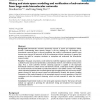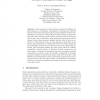322 search results - page 63 / 65 » Testing Deadlock-Freeness in Real-Time Systems: A Formal App... |
BMCBI
2007
13 years 7 months ago
2007
Background: Biomolecular networks dynamically respond to stimuli and implement cellular function. Understanding these dynamic changes is the key challenge for cell biologists. As ...
PLDI
2009
ACM
14 years 8 months ago
2009
ACM
As computer systems continue to become more powerful and comdo programs. High-level abstractions introduced to deal with complexity in large programs, while simplifying human reas...
AIIA
2007
Springer
14 years 1 months ago
2007
Springer
Abstract. Game generation systems perform automated, intelligent design of games (i.e. videogames, boardgames), reasoning about both the rule system of the game and the visual real...
GECCO
2004
Springer
14 years 26 days ago
2004
Springer
Abstract. Human-based genetic algorithms are powerful tools for organizational modeling. If we enhance them using chance discovery techniques, we obtain an innovative approach for ...
SIGSOFT
2007
ACM
14 years 8 months ago
2007
ACM
Automated verification is a technique for establishing if certain properties, usually expressed in temporal logic, hold for a system model. The model can be defined using a high-l...


